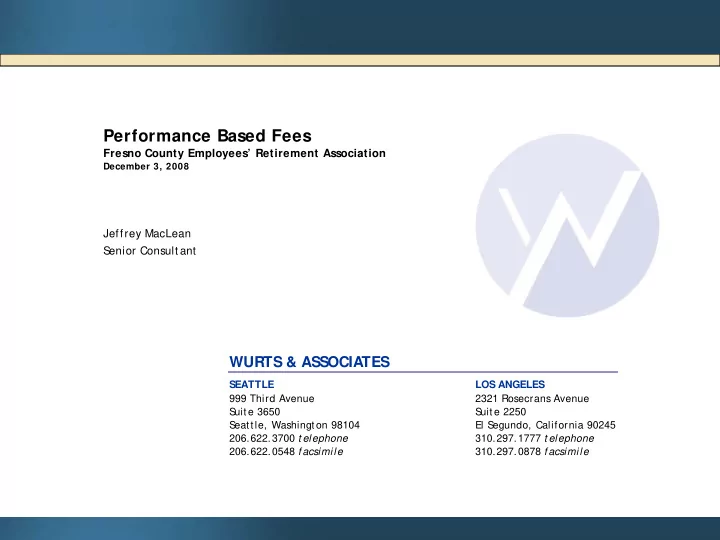

Performance Based Fees Fresno County Employees’ Retirement Association December 3, 2008 Jeffrey MacLean S enior Consult ant WURTS & ASSOCIA TES SEATTLE LOS ANGELES 999 Third Avenue 2321 Rosecrans Avenue S uite 3650 S uite 2250 S eattle, Washington 98104 El S egundo, California 90245 206.622.3700 t elephone 310.297.1777 t elephone 206.622.0548 f acsimile 310.297.0878 f acsimile
Performance Based Fees Background • Active managers exist to provide incremental return over a passive benchmark which can be purchased by a fund sponsor for less than 5 basis points depending upon the size of the mandate. • Active managers emphasize their historical record of beating a benchmark throughout the sales and marketing process. • Active managers enj oy significant margins in delivering their services to fund sponsors. They also have low marginal costs associated with adding a new client. • S tatistics indicated that few managers have been able to consistently add value relative to a passive benchmark. • Given these facts, fund sponsors started to implement Performance Based fees that reward excess returns. • FCERA currently only employs a Performance Based Fees with Brandywine. 2
Normal Fee Performance Based Fee Example • Assets: $100 million • Manager A Normal Fee S chedule: First $100 million: 70 basis points Next $100 million: 60 basis points • Base Fee (BF): 20 basis points • Required Excess Return (RER): 150 basis points Performance Based Fee: • If Manager A has underperformed the benchmark, Manager A only earns their base fee of $200,000, as opposed to earning their normal fee of $700,000. • If Manager A has outperformed the benchmark, Manager A will earn that base fee plus the performance fee. Calculation shown below: Performance Fee = [(NF-BF)/ RER] x (Portfolio Return-Benchamrk Return-BF) For illustrative purposes only 3
Performance Based Fee Worksheet Performance Based Fee Worksheet Manager: Manager A Client: Fresno County ERA Performance Fee Componets: Mandate: $100,000,000 PF = [(NF-BF)/RER] x (PR-BR-BF), where: PF = Performance Fee Fee Schedule: NF = Normal Fee (refer to Normal Fee schedule) First $100,000,000 0.700% BF = Base Fee Thereafter >$100,000,000 0.600% RER = Required Excess Return PR = Portfolio Return BR = Benchmark Return Annual Fee: First $700,000 0.700% Minimum Fee = Base Fee (BF) 0.20% Thereafter $0 0.000% Maximum Fee = [(2 x NF) - BF] 1.20% Total $700,000 0.700% NF = 0.70% BF = 0.20% RER = 1.50% Benchmark = R1000 Growth Annual Base Fee Annual Performance Fee Total Fee Performance Scenarios (PR-BR-BF) $ % $ % $ % 0.00% $200,000 0.20% $0 0.00% $200,000 0.20% 0.25% $200,000 0.20% $83,333 0.08% $283,333 0.28% 0.50% $200,000 0.20% $166,667 0.17% $366,667 0.37% 0.75% $200,000 0.20% $250,000 0.25% $450,000 0.45% 1.00% $200,000 0.20% $333,333 0.33% $533,333 0.53% 1.25% $200,000 0.20% $416,667 0.42% $616,667 0.62% 1.50% $200,000 0.20% $500,000 0.50% $700,000 0.70% 1.75% $200,000 0.20% $583,333 0.58% $783,333 0.78% 2.00% $200,000 0.20% $666,667 0.67% $866,667 0.87% 2.25% $200,000 0.20% $750,000 0.75% $950,000 0.95% 2.50% $200,000 0.20% $833,333 0.83% $1,033,333 1.03% 2.75% $200,000 0.20% $916,667 0.92% $1,116,667 1.12% 3.00% $200,000 0.20% $1,000,000 1.00% $1,200,000 1.20% For illustrative purposes only 4
Performance Based Fee Pro/Cons Pros: Cons: • Aligns the interests of the • Manager may “game” the portfolio manager and the fund sponsor. to add beta into the portfolio to achieve a higher fee or subtract • Matches the fee cash flow to the beta to hold onto the Performance economic well-being of the Based fees already earned. portfolio. • Can be complex to administer. • May be a good way to reduce fees paid to a manager and escape • Some managers argue that it is “most favored nation” clauses. inappropriate to create an Performance Based that may treat clients differently. 5
Performance Based Fee Components • Normal Fee: This is the managers normal active fee that the quote during the sales and marketing process. It usually has fee breakpoints at different asset levels, rewarding larger mandates with a lower average fee. • Base Fee: Fee manager is paid regardless of the performance obtained. These fee is usually more than what a fund sponsor would have to pay an index manager but substantially less than the normal fee. • Benchmark Return: Return of the agreed upon benchmark (i.e. Russell 3000 Value Index) • Required Excess Return: This is the required excess return that the manager must achieve to earn the Normal Fee. • Portfolio Return: Gross of fee actual portfolio return. • Average Market Value: Average of the beginning and ending market value of each quarter for the base fee. The average of the quarter-end market values comprising the period over which the performance fee is calculated. • Performance Fee: [(Normal Fee – Base Fee)/ (Required Excess Return)] x (Portfolio Return – Benchmark Return – Base Fee) • Total Fee: [Performance x Average Market Value] + Base Fee • Minimum Fee: The minimum fee is the base fee. • Maximum Fee: [(2 x Normal Fee) – Base Fee] • Phase in Provisions: One year for the first year, since inception basis for the first five years, and then rolling five years thereafter. 6
Recommend
More recommend